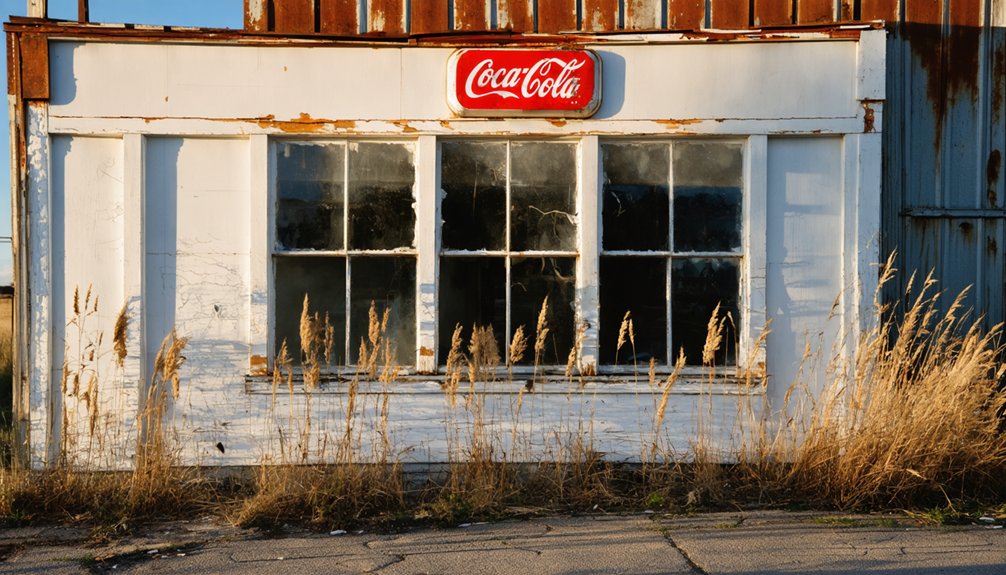You’ll find Kosciusko, Texas among the state’s most intriguing ghost towns, originally settled by Polish immigrants in 1854 under Rev. Leopold Moczygemba’s guidance. The town flourished into a vibrant agricultural community, reaching 950 residents by the 1940s, with St. Ann’s Church as its cultural heart. Today, abandoned structures and deteriorating streets tell tales of its prosperous past, while local legends of moonshine operations and mysterious happenings add to its haunting allure.
Key Takeaways
- Kosciusko declined from a peak population of 950 in the 1940s to become a ghost town after its school merged with Poth.
- The abandoned town features deteriorating structures and empty streets, drawing adventure seekers and ghost town enthusiasts.
- Local legends about a cannibalistic clan and connections to Texas Chainsaw Massacre mythology contribute to the town’s mysterious reputation.
- Despite its ghost town status, St. Ann’s Church remains active with 224 families, preserving the area’s Polish Catholic heritage.
- The town’s decline accelerated after 1933 when the repeal of prohibition ended its profitable moonshine operations.
The Polish Settlement’s Birth
While disasters plagued 1850s Poland with severe weather, floods, and disease outbreaks, a Franciscan priest named Rev. Leopold Moczygemba sparked hope from his position in Texas. His letters home to Silesia inspired the first wave of Polish immigrants to seek freedom in the Lone Star State.
These weren’t destitute refugees but resourceful farmers and artisans who could afford the nine-week journey across the Atlantic. Bringing their Polish customs with them, about 150-300 settlers arrived in December 1854, establishing what would become Kosciusko. The journey mirrored that of settlers who traveled nine weeks aboard the ship Weser to Galveston. The settlers found strength in their Catholic Church feasts which became central to their community life.
Like their predecessors who founded Panna Maria, they faced the challenges of Texas frontier life – sweltering heat, rattlesnakes, and cultural adjustments. They adapted their traditional building styles, adding wide verandas to combat the subtropical climate while maintaining their cherished immigrant stories and heritage.
Early Town Development and Growth
After its initial settlement, Kosciusko steadily grew into a thriving agricultural community, reaching its peak population of 950 residents in the late 1940s.
You’ll find deep community heritage here, with most current residents tracing their lineage to the original Polish and German settlers who ventured from Panna Maria-Cestohowa in the 1890s.
The town’s agricultural history shaped its development, with farming and ranching forming the economic foundation. Similar to how Tadeusz Kosciuszko himself advocated for reduced peasant labor on his Polish estate, the local farmers embraced progressive agricultural practices.
Significant progress came in the 1930s when electricity arrived for just $5 per connection, and State Highway 123’s construction in 1935 opened new trade routes.
The Farmer’s Gin Company, built in 1937, supported local cotton producers until 1953.
Though the population later declined to about 400, the tight-knit community maintained its cultural traditions through St. Ann’s Church and the Community Hall.
The community’s religious devotion was evident when five thousand people gathered for the dedication of the new St. Ann’s Catholic Church in 1951.
Railroad’s Impact on Local Commerce
Because of its strategic location along expanding Texas rail lines, Kosciusko emerged as an important commercial hub for Polish and German immigrant farmers in the 1890s. The railroad expansion transformed this small settlement into a significant supply point, where local merchants established stores to provide farming equipment, consumer goods, and agricultural necessities to the surrounding rural community. Similar to the transformative effect seen in Dallas’ population tripled, Kosciusko experienced rapid growth due to railroad development. The St. Louis Southwestern Railway brought increased connectivity and economic opportunities to the region. You’ll find that Kosciusko’s commerce benefited from the broader revolution in Texas agriculture during this period. As farmers shifted from subsistence farming to commercial crop production, particularly cotton, they relied heavily on the railroad for shipping their harvests to market and receiving manufactured goods from northern states. The town’s merchants played a pivotal role in this economic transformation, serving as intermediaries between the railroad-connected supply chains and the immigrant farming families who were building new lives in northeast Texas.
St. Ann’s Church: Community Cornerstone
Since its establishment in 1898, St. Ann’s Church has stood as the beating heart of Kosciusko’s Polish community.
What started as a modest wooden structure built by sixty-five Silesian families grew into an architectural marvel known as the “cathedral among the cactus.” You’ll find that by 1951, the church had transformed into a modified Gothic masterpiece, drawing over 5,000 people to its dedication.
The church isn’t just a place of worship – it’s where generations have gathered for community events and religious celebrations.
From its early school run by the Sisters of Charity to its Polish choir and various societies, St. Ann’s has preserved cultural traditions while adapting to change.
Even as Kosciusko evolved, the church remained steadfast, celebrating its centennial in 1998 with 224 families still calling it home.
Local Legends and Dark Tales
While St. Ann’s Church represents Kosciusko’s spiritual heritage, the town’s darker stories have left an indelible mark on its legacy.
You’ll find whispered tales of a cannibalistic clan that allegedly preyed on victims in the surrounding countryside, with rumors of violence and disturbing rituals that have persisted for generations.
These urban legends gained further traction when police investigations uncovered blood-stained equipment and buried teeth throughout the area.
Though DNA testing wasn’t available then, the discoveries led to widespread speculation and fear. The Kosciuszko Meat Market, run by an elderly couple who kept to themselves, became a focal point of local suspicion.
The once-vibrant community saw its decline when the school merged with Poth in the 1970s, leaving behind a ghost town of only about ten residents.
The town’s connection to the Texas Chainsaw Massacre mythology, while false, has only deepened its mysterious reputation.
Despite recent attempts to revitalize Kosciusko’s image through its dance hall and meat market, these dark tales continue to cast a long shadow over the community’s efforts at renewal.
The Dworaczyk Legacy
Among Kosciusko’s earliest settlers, the Dworaczyk family left an enduring mark on this Texas community after their arrival in 1856. Jacob Dworaczyk, a farmworker from Silesia, Poland, established his family’s roots here with his wife Johanna and young children.
Their Dworaczyk ancestry quickly became intertwined with the region’s development through marriage, business, and faith. Jacob helped establish Nativity of the Blessed Virgin Mary parish in 1873, demonstrating the family’s deep commitment to their religious heritage. Today, modern family history research helps connect descendants to their Dworaczyk roots.
You’ll find the family’s influence throughout Kosciusko’s history, from their early livestock holdings to the popular Dworaczyk’s Meat Market. They helped preserve Polish traditions while building the community’s foundation, contributing to local schools and the Catholic church.
Their legacy lives on through descendants who entered religious service and maintained farms in the area, shaping Kosciusko’s character as a vibrant Polish-Texan settlement.
Economic Rise and Fall

Kosciusko’s early economic significance stemmed from its position as a railroad supply hub in the 1890s, where Polish immigrants established essential businesses serving settlers heading toward San Antonio.
You’d find the town’s prosperity peaked during the early 1900s with its post office, meat markets, and dance halls creating a bustling agricultural trade center.
Railroad Supply Hub
Three key elements positioned Kosciusko as an essential railroad supply hub in late 19th century Texas: its strategic location along a major rail line, the region’s abundant cotton and timber resources, and the extensive use of convict labor for infrastructure development.
You’ll find the town’s railroad infrastructure centered around a bustling depot that served as the primary point for shipping and receiving goods. Local farmers and timber operations relied on the rail line to transport their products to larger markets, while the depot’s economic significance attracted businesses and workers to the area.
The railroad’s presence sparked rapid growth, with new warehouses and supply stores emerging to support the expanding commerce. Convict labor, though controversial, helped construct and maintain the essential rail connections that transformed Kosciusko into a thriving regional hub.
Moonshine to Ghost Town
Beyond its role as a railroad hub, Kosciusko gained notoriety for its thriving moonshine operations in the early 20th century.
You’ll find that moonshine production emerged as an essential source of economic resilience during local prohibition and the Great Depression, when legal jobs were scarce. The community’s moonshine legacy flourished as local support grew, with many residents viewing distillers as folk heroes who provided both income and affordable spirits.
While law enforcement occasionally raided operations, irregular enforcement and community protection allowed the trade to persist.
However, the repeal of prohibition in 1933 and Texas’s gradual relaxation of alcohol restrictions diminished moonshine’s profitability. As legal alcohol became readily available, Kosciusko’s economic foundation weakened, contributing to its eventual decline into a ghost town.
Cultural Heritage and Traditions
You’ll find Kosciusko’s Polish Catholic heritage deeply woven into the fabric of its community life, with traditions brought over by the original 1890s settlers from Panna Maria and Cestohowa.
The town’s social calendar revolved around church festivals, dance hall gatherings, and community celebrations that maintained strong ties to Polish customs and folk culture.
These gatherings served as essential connection points for local families, featuring traditional music, dancing, and shared meals that strengthened the bonds between Polish-Texan residents.
Polish Catholic Community Life
While many Texas towns grew around industry or commerce, Kosciusko’s heart beat through its vibrant Polish Catholic community centered on St. Ann’s Catholic Church. Built in 1898 for $2,000, this spiritual hub preserved both Polish traditions and Catholic rituals that defined the community’s identity.
You’d find the Sisters of Charity teaching at St. Ann’s School, where daily Mass and Polish language lessons kept cultural ties strong until 1968.
The parish’s influence extended beyond worship, with societies and a Polish choir organizing events that brought the community together. Even as late as 2012, visitors from Poland recognized how well their customs had been maintained.
The 1951 construction of a new Gothic-style church building proved the parish’s lasting impact on preserving Polish Catholic heritage in rural Texas.
Traditional Festivals and Gatherings
Even after church services concluded, Kosciusko’s community spirit thrived through diverse social gatherings centered at the Dworaczyk Meat Market.
You’d find locals and visitors from San Antonio mingling at the market’s bar area, where community dances and informal get-togethers strengthened neighborhood bonds.
Beyond the market, seasonal celebrations included farmers’ markets and outdoor picnics during agricultural off-seasons.
The town’s heritage came alive through folklore events commemorating General Thaddeus Kosciusko and visits from Polish travelers.
When St. Ann’s new church was dedicated in 1951, over 5,000 people participated in the festivities.
Today, you’ll find the town’s mysterious reputation drawing visitors to ghost tours and storytelling gatherings, where local legends – including the town’s connection to the Texas Chainsaw Massacre – keep oral traditions alive.
Modern-Day Ghost Town Tourism

Today’s adventure seekers and history enthusiasts flock to Kosciusko’s abandoned streets, drawn by the allure of its deteriorating structures and forgotten past. Urban exploration opportunities abound, attracting photographers and history buffs keen to capture the town’s haunting beauty and untold stories.
While you’ll find limited amenities, the site offers informational markers and designated parking areas for visitors.
Basic visitor facilities are available at the site, including marked parking spots and educational signage for tourists.
Tourist engagement has evolved through mobile apps and guided tours that bring the town’s history to life. You’ll want to exercise caution, though, as deteriorating buildings pose safety risks, and the remote location means emergency services aren’t readily available.
Local tourism initiatives have embraced social media marketing to showcase Kosciusko’s unique character, drawing a new generation of explorers while preserving its authentic ghost town atmosphere.
Preservation Efforts and Future Outlook
Despite its ghost town status, Kosciusko’s preservation groups work diligently to transform historical structures into engaging tourist destinations through careful restoration and modern facility upgrades.
You’ll find dedicated local historians leading educational tours and organizing cultural events that highlight the town’s Polish immigrant heritage and architectural significance.
The partnerships between regional historical societies and state preservation organizations have created sustainable frameworks for heritage tourism, ensuring these cultural treasures remain accessible for future generations.
Heritage Tourism Development
Through collaborative efforts between the Wilson County Historical Society and the Texas Historical Commission, Kosciusko’s heritage preservation has gained significant momentum in recent years.
You’ll find thorough heritage awareness programs featuring guided tours, interpretive signage, and multimedia presentations that showcase the town’s Polish immigrant history and mining heritage.
The tourism infrastructure has been thoughtfully developed to accommodate visitors while protecting fragile historical assets.
You can experience seasonal reenactments, explore the preserved bridge piers from 1914, and discover the stories behind St. Ann’s Church.
The site’s online presence connects through Texas ghost town networks, drawing history enthusiasts from across the region.
Local historians work closely with descendants of Polish and German settlers to guarantee authentic storytelling and preservation of oral histories.
Building Community Engagement
As local preservation advocates work to protect Kosciusko’s heritage, a dedicated community group formed in 1962 has spearheaded efforts to preserve the town’s abandoned courthouse and surrounding historical structures.
Through community outreach initiatives, you’ll find opportunities to join preservation activities that connect past and present generations.
Local partnerships with historical societies and regional museums have strengthened the town’s preservation network. You can participate in educational programs that highlight Kosciusko’s role in regional development, while engaging with descendants of original settlers who maintain deep connections to the site.
Despite lacking traditional municipal governance, grassroots volunteers and nonprofit organizations continue driving preservation forward.
Frequently Asked Questions
What Happened to the Original Polish Families Who Settled in Kosciusko?
You’ll find that while some Polish families preserved their heritage locally, others dispersed to nearby South Texas towns like Falls City and Poth, or moved to urban areas for economic opportunities.
Are There Any Descendants of Kosciusko Settlers Still Living Nearby?
As of 2009, around 390 residents lived in Wilson County, including descendants maintaining local heritage connections. You’ll find them preserving their Polish roots through St. Ann Church and cultural events nearby.
What Was the Peak Population of Kosciusko During Its Prime?
You’ll find that during the peak growth of the late 1940s, around 950 people called this area home – marking a time of historical significance before agricultural decline prompted urban migration.
Does Anyone Maintain the Old Cemetery Grounds Today?
Like whispers from the past, you’ll find dedicated volunteers and descendants still tending to the sacred grounds today, though ghost stories linger as they clear brush and maintain the weathered headstones.
When Was the Last Time Kosciusko Had an Active Town Council?
You’ll find the town council’s last active period was before mid-1900s, when local governance dissolved during Kosciusko’s decline and closure by law enforcement, leading to complete abandonment of formal town operations.
References
- https://www.youtube.com/watch?v=PCWCo10wQgc
- https://shop.oldsadsongs.com/blogs/locations/kosciusco-texas
- https://www.wilsoncountyhistory.org/talk-kosciusko
- https://www.wattpad.com/164189966-horror-stories-horror-blood-and-goyre-kosciusko
- https://www.texasescapes.com/SouthTexasTowns/KosciuscoTx/KosciuscoTexas.htm
- https://creepypasta.fandom.com/wiki/Kosciusko
- https://freepages.rootsweb.com/~atpc/genealogy/polonia/usa/plam-panna-maria.html
- https://www.tshaonline.org/handbook/entries/poles
- https://www.texasalmanac.com/articles/polish-texans
- https://en.wikipedia.org/wiki/History_of_Poles_in_the_United_States



